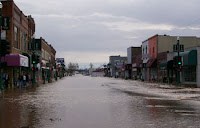 As storms soaked the Midwest this week, floods caused major damage, especially in Missouri, where 47 counties have been declared disaster areas. In southwestern Missouri, the town of Monnett experienced historic flooding, and the staff of its local newspaper, The Monett Times, was caught in some of the worst of it. (Times photo: A firefighter guides production manager Charlotte Brady across a flooded street. Below, another view of the flooding.)
As storms soaked the Midwest this week, floods caused major damage, especially in Missouri, where 47 counties have been declared disaster areas. In southwestern Missouri, the town of Monnett experienced historic flooding, and the staff of its local newspaper, The Monett Times, was caught in some of the worst of it. (Times photo: A firefighter guides production manager Charlotte Brady across a flooded street. Below, another view of the flooding.)Thursday morning, members of the 4,000-circulation evening paper's staff had to be rescued by firefighters, according to the paper's staff report. The staff had started putting up the floodgates and sandbags by 7 a.m. to stop the rising waters of nearby Kelly Creek, but by 9 a.m., firefighters began preparing for a rescue effort as waters were waist-high in the street outside the newspaper office.

The water started to recede after 11 a.m., and managing editor Murray Bishoff navigated his way into the building. Inside, water had reached a height of five-and-a-half inches, but with with water still on the floor — and near the high-voltage press equipment — The Times could not print for the first time in its history. Instead, The Times published its Thursday edition online by 9:30 p.m. Included in that coverage was Bishoff's report on the flood.
UPDATE, April 15: Bishoff reports to us that 120 bound volumes of his newspaper (30 years' worth) were damaged by the flood, and he is freezing them to prevent development of mold pending restoration. "The Missouri State Historical Society directed us to get them frozen immediately, so yesterday and today we wrapped them in plastic and hauled them off to the local production plant for International Dehydrated Foods, who will deep freeze them for us to stop the mold," he wrote. "The Northeast Document Conservation Center tells me that if you get a filing cabinet soaked, freeze your files in two-inch sections, divided by wax paper so you can pull two inches out at a time and thaw them bit by bit, rather than everything at once. For my bound volumes, a disaster recovery provider should be contacted next. They further advised me that vacuum freeze drying will cause the least amount of distortion. Two firms, Munters Corp., based in Chicago (800-686-8377), and BMS Catastrophe, based in Fort Worth (800-433-2940), specialize in that process."
No comments:
Post a Comment